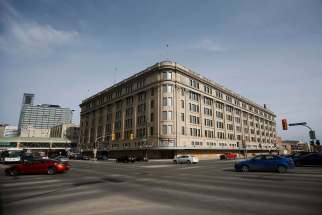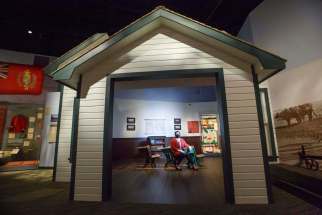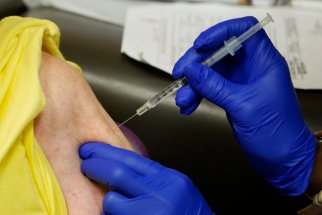Shared stories Manitoba Museum's new Prairies Gallery breathes life into history of the land we live on
Read this article for free:
or
Already have an account? Log in here »
To continue reading, please subscribe:
Monthly Digital Subscription
$0 for the first 4 weeks*
- Enjoy unlimited reading on winnipegfreepress.com
- Read the E-Edition, our digital replica newspaper
- Access News Break, our award-winning app
- Play interactive puzzles
*No charge for 4 weeks then price increases to the regular rate of $19.00 plus GST every four weeks. Offer available to new and qualified returning subscribers only. Cancel any time.
Monthly Digital Subscription
$4.75/week*
- Enjoy unlimited reading on winnipegfreepress.com
- Read the E-Edition, our digital replica newspaper
- Access News Break, our award-winning app
- Play interactive puzzles
*Billed as $19 plus GST every four weeks. Cancel any time.
To continue reading, please subscribe:
Add Free Press access to your Brandon Sun subscription for only an additional
$1 for the first 4 weeks*
*Your next subscription payment will increase by $1.00 and you will be charged $16.99 plus GST for four weeks. After four weeks, your payment will increase to $23.99 plus GST every four weeks.
Read unlimited articles for free today:
or
Already have an account? Log in here »
Hey there, time traveller!
This article was published 07/04/2021 (1706 days ago), so information in it may no longer be current.
An old friend is back at the Manitoba Museum.
The Bison Diorama, a longtime favourite display of three bison being charged down by a Métis hunter that has been under wraps for much of 2020, will again greet visitors when the Main Street landmark opens Thursday morning.
The return of the eye-catching, 15.5-metre work created by Manitoba artist Clarence Tillenius highlights the completion of a four-year, $20.5-million capital renewal project at the museum.
The museum is also lifting the curtain on a revamped Prairies Gallery, which had been called the Grasslands Gallery before renovations began in 2019.

It features Manitoba archeology everywhere you look and a far greater emphasis on Indigenous history and stories, the lack of which had been a source of criticism of the museum prior to the renos.
Kevin Brownlee, the museum’s curator of archeology who gave the Treaty 1 territorial acknowledgement at a press conference at the museum Wednesday, said the statement “transcended how we did our renewal of the galleries.”

The new gallery goes back to the basics, telling stories of the Dakota and the Métis and how the land and their lives were transformed when settlers moved in and mechanized agricultural practices took over, says Maureen Matthews, curator of cultural anthropology and part of the nine-member curatorial team for Prairies Gallery.
“It starts with the Prairies, the way they were before contact, and the last picture is a photograph looking down, and it’s just all little squares,” Matthews says. “It goes from this organic thing to being an endangered ecological space.
“The trajectory is the same for many of the people. Indigenous people suffered terribly when land was taken over for agriculture.”
There are displays on Indigenous agriculture, which archeologists discovered took place long before European explorers ventured into what became Western Canada; centuries-old Aboriginal leather garments that are encased in climate-controlled display cases that allow the fragile items to be viewed by the public; and a replica of a one-room schoolhouse that offers a lesson into the history of Indian residential schools in Manitoba.
“It is really a hard, raw history that’s being presented, but we also wanted to have the hopeful side of it, and talk about survivors’ stories.”–Amanda McLeod
“It is really a hard, raw history that’s being presented, but we also wanted to have the hopeful side of it, and talk about survivors’ stories,” says Amanda McLeod, an Indigenous curatorial assistant who comes from Sagkeeng First Nation.
“How many times do you ask somebody to relive what they’ve already shared? So I did go to stories that already had been shared in the process of the Truth and Reconciliation Commission.”
Visitors will eventually get to use touchscreens built into students’ desks — because of pandemic guidelines, they’re currently turned off — that include a constant scroll of the names of those who died at the schools, as well as memories from the likes of artist Jackson Beardy, a former employee at the museum and also one of the Indigenous Group of Seven who had been at the residential school in Portage la Prairie.
About the only things that remain from the Grasslands Gallery are an old Red River cabin and a giant teepee, donated in 2007 by the Hall family from Sioux Valley Dakota Nation in western Manitoba. It now has a new lining, concealing speakers that offer a 20-minute audio loop for those who venture inside the traditional Aboriginal shelter.
“To see that we managed, in spite of all the chaos of renovations, to maintain the connections between our museum and the family means a great deal to us,” Matthews says. “You walk in, you hear them talking. It feels like you’re hanging out with them, and that their teepee is your teepee.”
The chronological look at the Prairies winds up with settlers’ stories: the transformation of the Prairies into the world’s breadbasket during the early part of the 20th century; the hardship of the Great Depression; the depopulation of rural Manitoba that has turned villages into ghost towns.
The removal of a wall at the gallery’s entrance gives greater prominence to Indigenous artist Daphne Odjig and her mural The Creation of a World, which was painted in 1972 for the museum’s opening. It now is paired with a new mural, Rhythmic Movement in the Grasslands by Winnipegger Dee Barsy, who is also a member of Skownan First Nation, near Lake Winnipegosis.
The museum takes pride in Odjig’s mural, having recognized her talent before she became known as one of Canada’s top artists and a member of the Indigenous Group of Seven. There are high hopes for Barsy as well.
“Dee Barsy’s work was beautiful; we loved it,” Matthews says. “We really hope that 50 years from now we’ll be able to say ‘We knew her back when she was just a student.’ “
The museum, including the Prairies Gallery, is open Thursdays to Sundays from 11 a.m. to 5 p.m. (The Science Gallery and the Planetarium remain closed, owing to the pandemic.)
alan.small@freepress.mb.ca Twitter:@AlanDSmall

Alan Small has been a journalist at the Free Press for more than 22 years in a variety of roles, the latest being a reporter in the Arts and Life section.
Our newsroom depends on a growing audience of readers to power our journalism. If you are not a paid reader, please consider becoming a subscriber.
Our newsroom depends on its audience of readers to power our journalism. Thank you for your support.
History
Updated on Thursday, April 8, 2021 6:08 AM CDT: Fixes typo
Updated on Thursday, April 8, 2021 9:05 AM CDT: Corrects time references
Updated on Thursday, April 8, 2021 9:07 AM CDT: Fixes typo
Updated on Friday, April 9, 2021 7:57 AM CDT: Clarifies Dee Barsy is a Winnipegger and member of Skownan First Nation.










